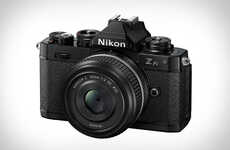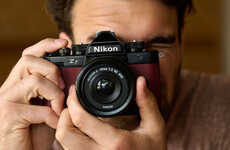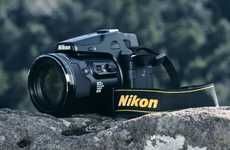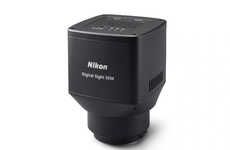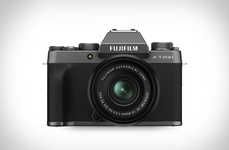
The Nikon D5500 is Calling the Shots At CES 2015
Rahul Kalvapalle — January 7, 2015 — Tech
The Nikon D550, unveiled at CES 2015, is the first Nikon DSLR to feature touchscreen capability.
This camera is powered by a 24.2-megapixel APS-C CMOS sensor designed without any optical low-pass filter, enabling it to produce sharper images. It is also equipped with an Expeed 4 image processing engine that helps to produce quality images in a wide variety of lighting conditions and situations. The camera has an ISO range of 100 to 25600 and a pretty decent maximum burst rate of 5 frames per second.
The touchscreen is clearly the highlight feature however; this 3.2-inch LCD touchscreen can be used to navigate camera settings with ease.
The Nikon D550 will be available in February in red or black.
This camera is powered by a 24.2-megapixel APS-C CMOS sensor designed without any optical low-pass filter, enabling it to produce sharper images. It is also equipped with an Expeed 4 image processing engine that helps to produce quality images in a wide variety of lighting conditions and situations. The camera has an ISO range of 100 to 25600 and a pretty decent maximum burst rate of 5 frames per second.
The touchscreen is clearly the highlight feature however; this 3.2-inch LCD touchscreen can be used to navigate camera settings with ease.
The Nikon D550 will be available in February in red or black.
Trend Themes
1. Touchscreen DSLR Cameras - The addition of touchscreen capability to DSLR cameras provides a more intuitive user experience and opens up opportunities for innovative camera controls and features.
2. 24.2-megapixel APS-C CMOS Sensors - The use of high-resolution CMOS sensors without optical low-pass filters enables DSLR cameras to capture sharper and more detailed images, creating opportunities for clearer and more vibrant photographs.
3. Expeed 4 Image Processing Engines - The integration of advanced image processing engines in DSLR cameras allows for faster and more efficient image processing, creating possibilities for real-time adjustments and enhanced image quality.
Industry Implications
1. Camera Manufacturing - The camera manufacturing industry can explore the development of touchscreen DSLR cameras with innovative features and user-friendly interfaces to attract customers and differentiate from competitors.
2. Photography Equipment Retail - Photography equipment retailers can capitalize on the demand for DSLR cameras with high-resolution sensors and advanced image processing engines by offering a wide range of models and customization options to cater to different customer preferences.
3. Software Development - Software developers can create innovative camera control applications and image processing algorithms that leverage the capabilities of touchscreen DSLR cameras, enhancing user experience and enabling creative possibilities.
6.1
Score
Popularity
Activity
Freshness


